
by Matthew Orwat | Sep 30, 2021
By Matthew Orwat and Judy Corbus
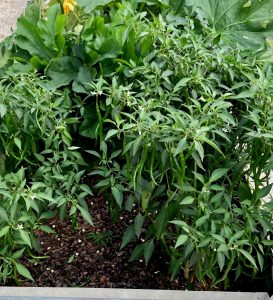
Cayenne Peppers growing this summer. Image Credit Matthew Orwat UF / IFAS Extension Washington County
As fall begins we often begin to think about the successes and failures of our vegetable gardens. Two of my successes this past summer have been pepper and basil.
A variety of peppers work great as transplants in mid to late spring. This spring a large variety of peppers were planted including Cayenne, Bell, Cubanelle, Habanero, Poblano, Anaheim, Cajun Belle, Havasau, Serrano, Jalapeno, and Banana. A loose, rich media was used containing coconut coir and composted organic humus to provide an excellent well-drained location which also retained moisture. Finding this delicate balance is difficult but can be achieved by using coconut coir and organic matter based garden soil mixtures. After the peppers were planted, they were side-dressed twice with a standard bagged 8-8-8 fertilizer blend containing micronutrients and once with an organic fertilizer. During the heat of the summer it was important to water the peppers at least every other day. Need for watering decreased as the fall weather approached, but was still necessary.
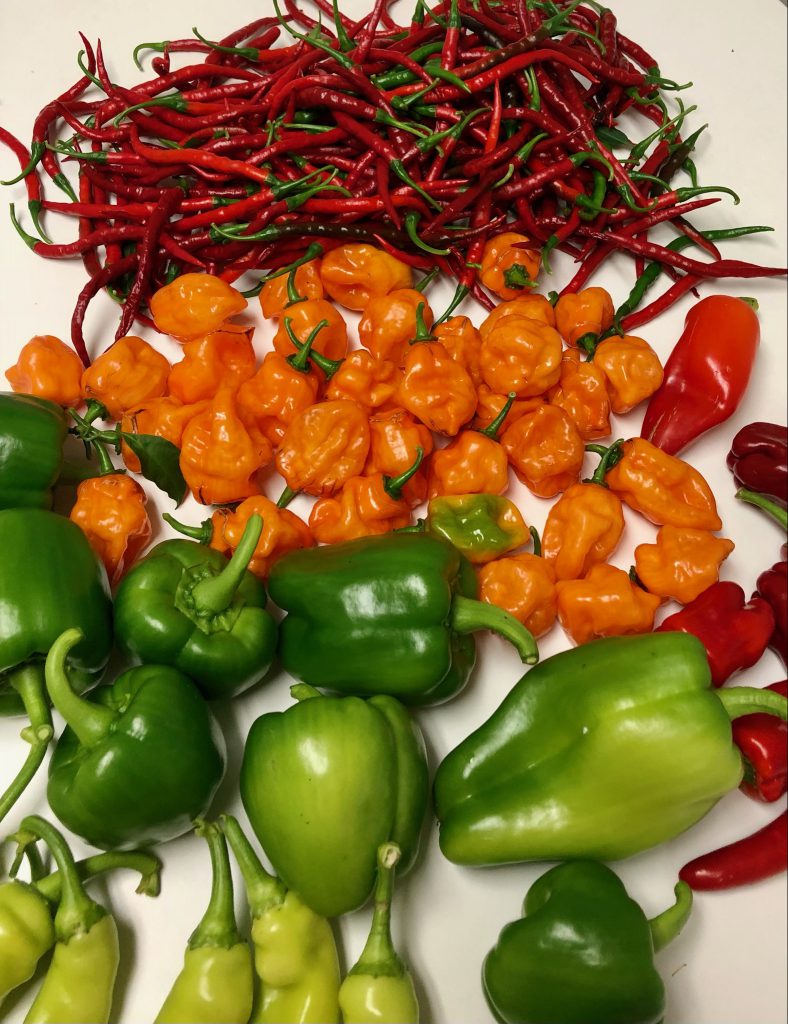
Bountiful Pepper Harvest. Image Credit Matthew Orwat UF / IFAS Extension Washington County
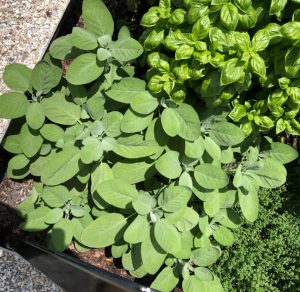
Sage and Basil Image Credit Matthew Orwat UF / IFAS Extension Washington County
In fall, many gardeners think it might be a good time to remove their peppers plants, but they can be encouraged to produce peppers until frost and maybe a little later with protection. Oftentimes it is more practical to start or transplant new pepper plants the following spring, but it is possible to pot up and overwinter peppers in a sheltered area or greenhouse.
In addition to peppers, basil was especially bountiful this year. To save my basil bounty for the winter I have options to dry, blanch or make pesto. This should be done before the first frost, since basil is very sensitive to freezing temperatures. Other herbs that will usually overwinter well in the garden include thyme, chives and rosemary. They will need little to no protection. Additionally, sage might come back the following year if it is in a protected area. Herbs such as cilantro and parsley will thrive in our North Florida winters and should be planted now.
To preserve the bounty of your harvest for later use, you may can, pickle, or freeze peppers. Follow these USDA-approved guidelines from the National Center for Home Food Preservation:
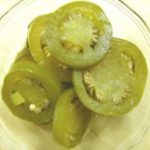
Credit : National Center for Home Food Preservation
Canning: https://nchfp.uga.edu/how/can_04/peppers.html
Pickling:
Freezing:
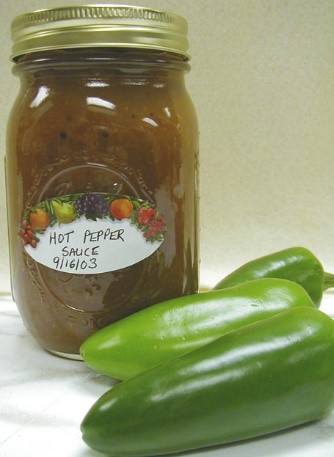

by Matthew Orwat | Jul 29, 2021
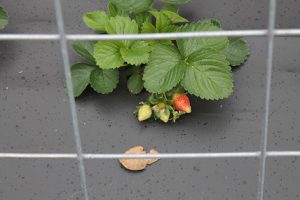
Strawberries growing on “plastic” to protect them from water splashed fungal spores found in soil. Image Credit: Matthew Orwat UF/IFAS Extension Washington County
As the alternating cycles of sun, heat and rain shape our summer days, I start thinking about cooler times of the year, the fall planting season. One plant to consider planting in the fall are strawberries. Planting strawberries in the fall is really an exercise in preparation for bountiful production of fruit beginning in January and continuing into May and June. The following procedure will lead to a successful strawberry production if followed!
The best location for strawberry production provides well-drained, moist, sandy soil with substantial organic matter. It must not be too wet. pH should be between 5.5 and 6.5, which is considered slightly acidic. A fertilizer scheme of 2 lbs. of a 10-5-10 fertilizer per 100 sqft of raised bed or 10 feet of row should be applied at pre-plant, with ¼ of the fertilizer over the top and the rest in a one-inch-deep band near the location of drip irrigation.
*DO NOT apply fertilizer directly below the plants, as the fertilizer may burn the young transplants.

This is a raised bed of strawberries, which has been filled with rich composted growing media. Image Credit: Matthew Orwat UF/IFAS Extension Washington County
Commonly, a preferred system is the development of a hill system, which is 6-8 inches high and 24 inches wide. Drip irrigation should be installed for best results, thus keeping the leaves free of irrigation water. This hill should be covered with weed barrier, such as grower’s polyurethane plastic to reduce weed growth and soil splashing onto leaves. Additionally, strawberries do well when planted in a raised bed. This system can still utilize weed barriers and drip irrigation but gives the gardener the added benefit of manipulation of the growing media. Growing media made up of compost and coconut coir works especially well for this and may be found at local large garden centers.
Short day cultivars that have been proven to do well for home gardeners in Northwest Florida production are Sweet Charlie and Camarosa and should be purchased certified disease free from a reputable nursery. Both dormant bare root and actively growing plug plants are available for purchase, but I have had best luck with actively growing plug transplants.
While strawberry plants can easily withstand our winter temperatures, fruit can suffer damage from frosts below 32 degrees Fahrenheit. The good news is that small row covers or “low tunnels” can be constructed to prevent fruit loss and encourage early fruiting.
When setting out the transplants:
- Keep plants moist before planting
- Spread roots out in fan-shape
- Set plants in moist soil at the correct depth. Do not cover the plants crown with dirt or leave its roots exposed above the soil.
- Space plants 12 to 18 inches apart.
- Pack the soil firmly around the roots, then sprinkle with water. Overhead sprinkling may keep the tops from drying out until the roots can get established.

Homemade row cover for strawberries made of cow panels and sheets. Commercial row covers can be purchased using hoops and frost cloth. You can also make your own with pipes and bulk rolled frost cloth. Image Credit: Matthew Orwat UF/IFAS Extension Washington County
As stated above, strawberries should be mulched. Black polyethylene plastic mulch at 1 to 1½ mil thick is best (completely cover the top and sides of bed before planting). Be sure the bed is firm, formed correctly, moist, and fertilized adequately. Place soil on the edges of the plastic to hold it in place. Cut slits in the plastic for the transplants.
When using alternatives like straw, bark or other natural organic materials mulch to a depth of 1 to 2 inches, but do not completely cover the plant.
For more information, Please consult these references or contact your local extension agent:
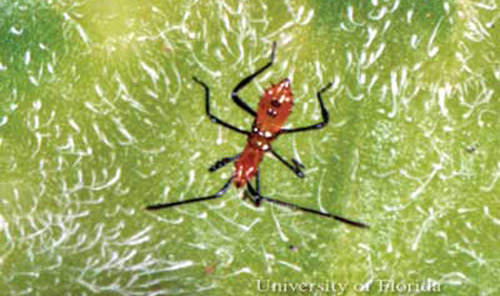
by Matthew Orwat | Mar 25, 2021
Stinkbugs and their relatives are not always problematic in the flower or vegetable garden, but when they become so, they can suck the life out of our fruits and vegetables, create ugly abrasions, and destroy flowers such as roses.
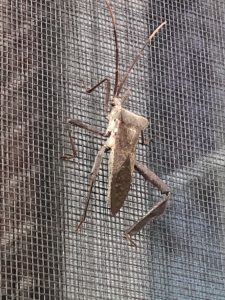
Over-wintering adult leaffooted bug emerging from hibernation . Image Credit Matthew Orwat, UF / IFAS Extension
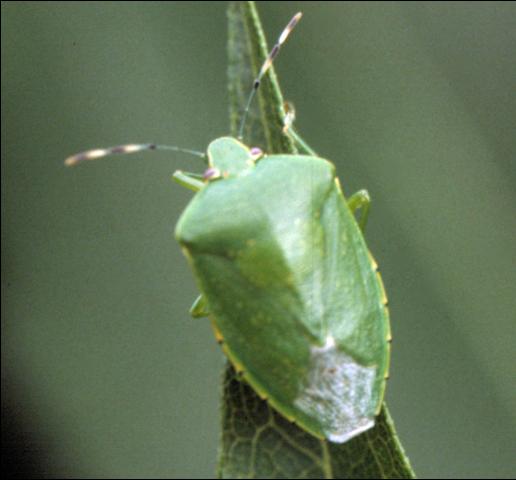
The green stink bug Acrosternum hilare (Say). Image and caption credit EDIS, Dr. Russ Mizell
What is a Stink Bug?
The stink bug (Pentatomidae family) is a major garden pest of a variety of fruits and vegetables including squash, peppers, tomatoes, peaches, plums, pecans and a variety of other edibles. They are known as a “piercing and sucking” insect because that’s the way they feed, by using their mouth, or proboscis, just like a needle to pierce the fruit and suck out the juices. This feeding leaves a damaged area of the fruit which may develop discoloration, rot or fungal disease and render the fruit unsaleable or inedible.
Who are “their relatives”
The leaf footed bug, Leptoglossus phyllopus (L), is a relative of the stinkbug and feeds in the same way, has a similar lifecycle and causes similar damage. They are usually slightly larger and have “leaf like” appendages on their legs which are their namesake.
What is their lifecycle?
In Florida, overwintering adult stink bugs will place a clutch, or tight group of eggs, on a host plant early in the growing season. If their preferred plant is not available, they use a variety of weeds and grasses to lay eggs upon and provide food for their young. After eggs hatch, they go through several nymph stages before they finally reach the adult stage. Stink bugs have multiple generations in a year, often four to five. They readily move to find preferable food sources and might appear in a garden without warning to feed and cause destruction.

Nymph of the leaffooted bug, Leptoglossus phyllopus (L.). Photograph by Lyle J. Buss, University of Florida.
How are they best controlled?
First of all, many stink bugs use weeds as host plants to gather and feed upon, so controlling weedy plants around vegetable and fruit gardens might limit their numbers. If stink bugs are a major problem, planting trap crops, such as sunflowers, is beneficial. Stink bugs prefer to feed on sunflowers more than some other vegetables. This situation can be used to the gardener’s advantage by mechanically killing or spraying stink bugs on trap crops while avoiding treating food crops with pesticides. More information on trap cropping can be found here.
Additionally, stink bug traps are available. These mechanically trap stink bugs, thus reducing their numbers in the garden, but need to be monitored and serviced regularly. Several species of parasitic Tachinid flies are also predators of stink bugs. These flies lay their eggs on adult stink bugs. The fly larva use the bug as a buffet, slowly killing the bug.
Stink bugs are difficult to control with insecticides, but some measure of control can be achieved at their nymph stage with various approved fruit and vegetable insecticides containing pyrethrins. These products are readily available at local garden centers and feed & seed stores.
For more information, please check out the following resources:
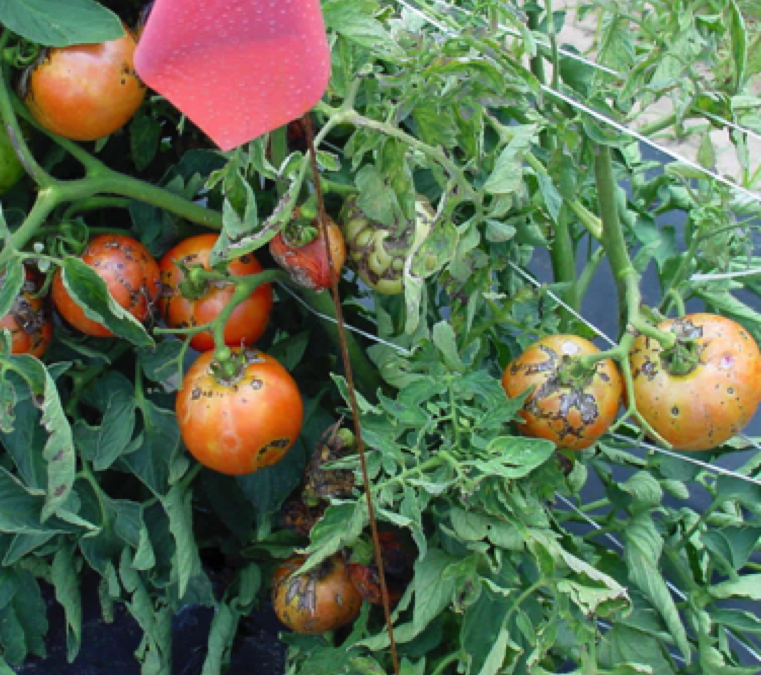
by Matthew Orwat | Feb 25, 2021

Tomatoes ripening on the vine – Image Credit Matthew Orwat UF/IFAS Extension
It is late-February, so the spring growing season is just around the corner. Now is the time to be thinking about which tasty tomatoes you want to plant in your home garden! Although tomatoes are a favorite kitchen staple, they prove challenging to grow in the Florida Panhandle climate.
While many tomato diseases can kill plants, damage fruit, and reduce yields, genetic resistance or tolerance to select diseases exist. The following are three of the most common diseases and viruses home gardeners face, for which resistant and tolerant varieties exist.
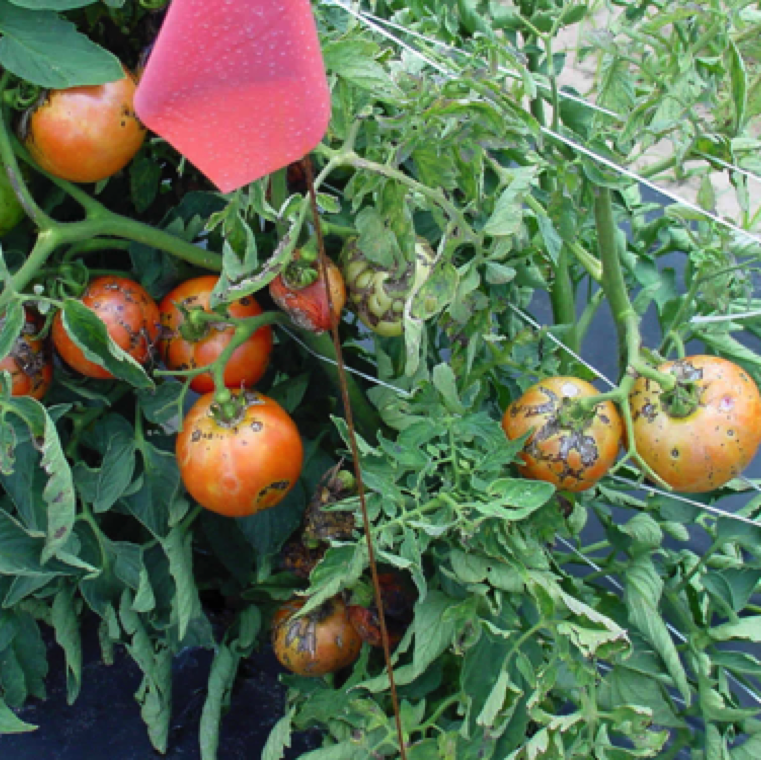
Tomato spotted wilt affects tomatoes, and numerous other vegetables, ornamentals, field crops and weeds. The disease can cause significant yield losses of tomato. Image Credit UF/IFAS Plant Pathology UScout Site
Tomato Spotted Wilt (TSW) is a viral disease which is transmitted by thrips, a species of insect that is very small and not always visible when checking the garden for insect pests. They love to feed on the sugary juices of the tomato flowers, and while feeding, they have the opportunity to transmit the virus through their piercing and sucking mouth parts. Lots of different symptoms may occur with TSW. Initially growers will notice light or dark brown spots on leaves of affected tomatoes, next wilting or stunting will occur, along with brown or purple streaks on the stems. Finally, fruit will exhibit unsightly brown rings throughout. The good news is that home gardeners can get a head start on this disease by planting resistant cultivars. When shopping for seed or transplants, growers should look for plants listed with the codes TSW or TSWV, because these have demonstrated resistance to Tomato Spotted Wilt Virus.
Another viral disease often found in the tomato garden is Tomato Yellow Leaf Curl (TYLC) Virus. TYLC first appeared in Miami in 1997 and was brought to Florida by infected whiteflies. Much like TSW, TYLC is spread from plant to plant by feeding whiteflies. As the name indicates, TYLC symptoms include curled leaves and stunted growth. Infected plants produce little to no fruit. Strategies to reduce the possibility of virus transmission to the garden include reducing the population of weedy plants, which may harbor whiteflies. Fortunately, resistant cultivars are available in plant catalogs, and are denoted by TYLC to indicate resistance.

Spread of TYLC is by the feeding of TYLCV infected adult whiteflies. Mechanical or seed transmission is not known to occur. Upward curling and yellowing of the leaves is an early symptom. Credit: UF/IFAS Plant Pathology UScout Site
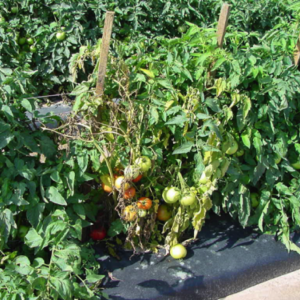
Blighting of leaves and wilting of part or entire plant can expose fruits to sunscalding thereby further affecting yield of affected plants in production. Credit: UF/IFAS Plant Pathology UScout Site
Fusarium Wilt is one of the oldest diseases to affect tomatoes in the state of Florida and is caused by the fungal pathogen Fusarium oxysporum f.sp. lycopersici races 1, 2, or 3. This pathogen is often present in regional soils and moved by wind. Once it enters the roots of tomato plants, fusarium wilt proliferates and clogs the vascular system, much like a clog in the plumbing of a building. Thus, the primary symptom is the wilting of the plant, which will first be noticeable on hot days, despite adequate irritation. Once infected, there is no cure, and infected plants should be removed and destroyed to stop the spread. The good news is that resistant cultivars are available to the various fusarium races. They are usually denoted as F-R 1, 2, or 3 in seed catalogs. Additionally, look for plants labeled VFN. These cultivars are resistant to a different kind of wilt, called verticillium, as well as fusarium and nematodes.
Fortunately, the UF / IFAS publication “Tomato Varieties for Florida—Florida “Red Rounds,” Plums, Cherries, Grapes, and Heirlooms” by Monica Ozores-Hampton and Gene McAvoy has provided us with a handy chart of tomato varieties with disease resistance. Codes in the columns indicate disease resistance to specific pathogens. While there is no single tomato variety resistant to all possible disease pathogens, planting different varieties with several different types of resistance will allow growers to hedge against attack by a number of potential disease problems. Some of the more common disease resistant tomato varieties planted in this area are ‘Quincy’, ‘Bella Rosa’, ‘Amelia’, ‘Tasti-Lee’, ‘BHN 602’, and ‘Volante’.
For a further look at the various diseases of tomato, the EDIS publication “A Series on Diseases in the Florida Vegetable Garden: TOMATO” offers more detail. Another resource UF/IFAS offers for disease diagnosis is the NFREC U-Scout website. U-Scout provides information on more than 40 potential disease issues in tomato. Additionally, any plant disease can be diagnosed through your County Extension Office or by submitting samples to the Plant Pathology Clinic, at the North Florida Research and Education Center, for only $30/sample for basic services.
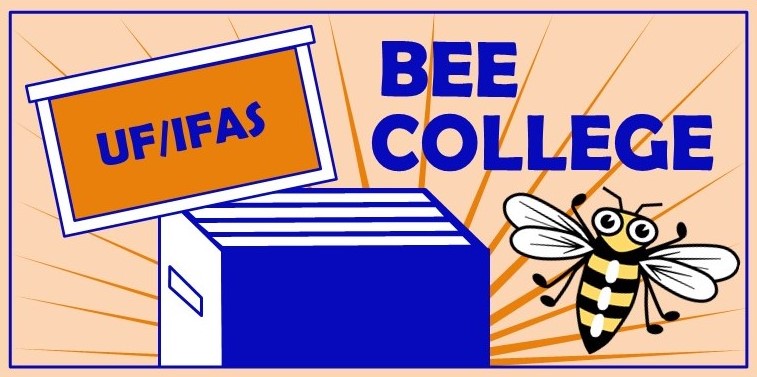
by Matthew Orwat | Feb 18, 2021
Join the University of Florida/Institute of Food and Agricultural Sciences (UF/IFAS) Honey Bee Research and Extension Laboratory for the 2021
Spring Virtual UF/IFAS Bee College! Imagine
FOUR Saturday mornings in March 2021 of all things honey bees. Those new to beekeeping can follow the beginner track, while more experienced beekeepers can participate in sessions focused on honey bee stressors and other advanced topics related to beekeeping. Speakers include UF/IFAS faculty, staff, students, members from the Florida State Beekeepers Association, specialists from Bee Informed Partnership, and other honey bee specialists around the world! Participants can choose to attend one session or all four as a
“Package Deal” for a reduced fee.
Register for the “Package Deal” or for each session separately– whatever works best with your schedule.



















